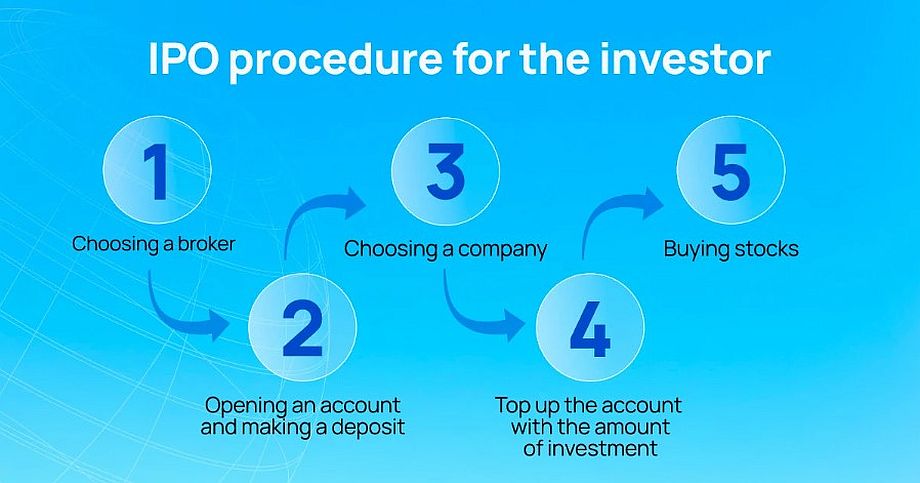IPO for the investor: benefits and procedure
IPO (Initial public offering) — is the initial public offering of shares on the stock exchange. When a company participates in an IPO, it ceases to be private and becomes public, and its shares can be bought by anyone. Thus, the company attracts investments which it then uses to develop its business. Participating in IPO for the investor is an opportunity to augment capital, earning money on investments in stocks.
The IPO market is actively growing, and even in 2020-2021, when the world was experiencing an economic crisis, many companies conducted IPOs: Airbnb, Snowflake, Coinbase, Bumble, and others. Regardless, before you invest in an IPO, you need to understand how the system works internally. This is the topic of our article.
IPO procedure for the investor
To invest in companies‘ stocks in an IPO, the investor needs to go through several steps.
Step 1: Choose a broker
It is not possible for a private investor to simply go to the stock exchange and buy shares. For this purpose it is necessary to choose a broker and conclude a contract with him. A broker may be represented by any company, which has a license for performance of brokerage activity.
Step 2: Open an account with the broker and make a deposit
The sum of the deposit depends on the broker, with which you will work. For example, American brokers require a deposit from $5000, but you can work with them directly. If you work through an intermediary, the deposit will be less, but you will have to pay a commission.
Step 3: Choose one or more companies, whose shares you want to buy
For this purpose, you have to ask the broker for a list of companies, which are planning to go public. The broker will then provide you with a short list of the most promising companies. You can also independently review the list of companies on the IPO calendar. For example, the Nasdaq exchange provides the most up-to-date information about IPOs.
To make sure that your investment will be profitable, pay attention to the following parameters before selecting a company whose shares you want to buy.
– The bank underwriting the company. Pay attention to the bank that helps the company go public. Prestigious underwriters are concerned about reputation, so they will not cooperate with dubious organizations.
– Strategy. Carefully study the company’s business strategy, plans, and positioning.
– The company’s industry. It is important for an investor to be close to the company’s industry and understand how promising it is. If the branch of the company is new to you, take time and study the sphere, all its subtleties.
– Financial situation. Look at how much revenue the company has, whether it has debts to investors, or loans from banks.
Step 4: Fund your account with the amount you plan to invest
Once you have chosen a company, you need to apply to buy shares through a broker. In order to do this, the investor must have at least $2,000 in the account (the amount depends on the particular brokerage company). Experienced investors advise dividing the desired amount of investment by three, thereby investing only a third. Then, despite the fact that part of the money will be frozen, the remaining amount you can invest in other areas and expand your investment portfolio.
Step 5: Buy shares and wait for the end of the freezing period
To prevent speculation by investors, a lock-up period is established, which is a period of time during which you cannot sell the purchased shares. The lock-up period lasts for 92 days. During this time, the stock may both rise and fall. For example, shares of Facebook (since recently Meta) fell by 50% during the lock-up period. But they soon rose, and are now considered one of the most profitable assets.
If you bought a stock, but you see that it’s falling and you don’t have any faith in it growing further, you can enter into a forward contract. That is, fix the price of the asset for part or all of the stock, and sell it after the end of the period.
Why should an investor participate in IPO
In addition to obtaining additional income, investing in shares allows the investor to:
– Help develop a startup that may become a second Apple;
– Participate in the development of the company;
– Expand their investment portfolio;
– Receive dividends or a percentage of the company’s profits.
The biggest risk of participating in an IPO for an investor is if the company goes bankrupt or is taken off the stock exchange. To protect yourself from this, remember a few rules.
1. Carefully study information about the company. Check everything: the management team, financial documents, media mentions, strategy and plans, goals for the use of investment funds, the team of professionals. If you see that the company has been involved in scandals, fraud, cheating employees/customers — it is better not to do business with it.
2. Invest in several companies. As you wrote above, divide the amount you planned to invest into several parts. This way you will protect yourself, and the money will “work” and bring income.
3. Don’t be in a hurry to sell the stock after the price falls. At first, a company’s stock may fall as well as rise. It all depends on the organization’s performance, reputation, and plans. In addition, if you sell assets early, you lose money on commissions.
Key takeaways
The IPO procedure consists of five steps, the main ones being choosing a broker and a company whose shares you want to buy. It is important to be vigilant at each stage in order to invest in really promising assets and get a good return: dividends, a percentage of profits or the opportunity to participate in the development of the company.
At S-IPO you get a team of professional analysts who analyze the market and assess risks, providing investors with the most favorable offers. You only need $500 to start investing, and the annual return on investment with S-IPO is 150%.

